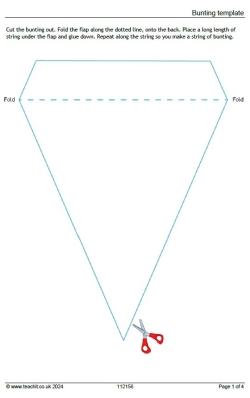Bunting template

These bunting templates, available in both free and editable versions, can be customized and used in the classroom in a variety of ways to support learning, such as vocabulary teaching, reinforcing concepts, celebrating achievements, event decorations, seasonal decorations and much more.
What’s included
- FREE blank bunting template PDF
- Editable and customisable bunting template (Word doc)
How to use these bunting templates
For the FREE bunting template, simply cut the bunting out, fold the flap along the dotted line, onto the back, then place your string under the flap and glue down. Repeat along the string so you make a string of bunting. Your bunting can be printed onto coloured or patterned paper, or you can decorate it with craft materials or coloured pencils and pens.
The editable version of the bunting template is available to subscribers and can be customised with letters, words and phrases as required. Perfect to help support learning, brighten up your classroom or celebrate a special event!
Ideas for using bunting templates in the classroom
- Spelling and vocabulary: Customise the bunting with new vocabulary or spelling words. Each flag can represent a different word, and students can refer to the bunting during lessons or activities. This is particularly helpful for visual learners.
- Celebrating achievements: Bunting can be used to celebrate students' achievements. Each flag can represent a different student or a different achievement. This can be a great way to foster a positive and supportive classroom environment.
- Event decorations: Special events like school plays, concerts, or festivals can be spruced up with thematic buntings. Students can be involved in creating and decorating them, making it a fun and engaging activity.
- Seasonal decorations: Buntings can be used to celebrate different seasons or holidays. This can create a festive atmosphere in the classroom and help make learning more enjoyable.
- Teaching history or geography: Use bunting to represent different countries, case studies or historical events. This can be a great visual aid to support lessons and stimulate discussions.
- Maths activities: Each flag on the bunting can represent a different maths problem for students to solve or a formula to learn. This can be a fun way to review material or introduce new concepts.
- Teaching languages (MFL): Bunting can represent different words or phrases in the target language. Each flag could have a word or phrase, and its translation, helping students to learn new vocabulary. This can be a fun and engaging way to support language learning.
